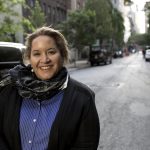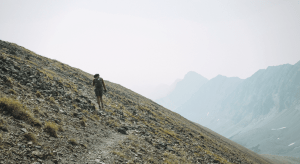Episode Notes
As protests and riots continue in America over police brutality and persecution of people of colour, Australia’s own injustices against Aboriginal and Torres Strait Islander people must also be subject to public scrutiny. Join Aboriginal Australian activist and human rights lawyer, Professor Megan Davis, alongside host Ginger Gorman as they reflect on the significance of the Uluru Statement from the Heart three years on, and steps to reconciliation and equal political representation of Aboriginal and Torres Strait Islander people.
Ginger Gorman: Right now, in the wake of the terrible summer fires, the ongoing fallout of the COVID-19 pandemic and the global resurgence of the Black Lives Matter movement, we find [01:00] ourselves in a strange state of flux.
With me now to talk through some of these issues is Professor Megan Davis. She’s Pro Vic-Chancellor Indigenous at the University of New South Wales and also a Professor of Law. Megan is a human rights lawyer with expertise in constitutional law and the rights of indigenous peoples. She’s a fellow of the Academy of the Social Sciences in Australia and Cobble Cobble woman from South East Queensland.
Megan, thank you so much for joining me.
Professor Megan Davis: Thank you for having me.
Ginger: May I please invite you to read the Uluru Statement from the Heart, first off.
Professor Megan Davis: Yeah, sure.
The Uluru Statement from the Heart.
We, gathered at the 2017 National Constitutional Convention, coming from all points of the southern sky, make this Statement from the Heart:
Our Aboriginal and Torres Strait Islander tribes were the first [02:00] sovereign Nations of the Australian continent and its adjacent islands, and possessed it under our own laws and customs. This our ancestors did, according to the reckoning of our culture, from the Creation, according to the common law from ‘time immemorial’, and according to science more than 60,000 years ago.
This sovereignty is a spiritual notion: the ancestral tie between the land, or ‘mother nature’, and the Aboriginal and Torres Strait Islander peoples who were born therefrom, remain attached thereto, and must one day return thither to be united with our ancestors. This link is the basis of the ownership of the soil, or better, of sovereignty. It has never been ceded or extinguished, and co‑exists with the sovereignty of the Crown. [03:00]
How could it be otherwise? That peoples possessed a land for sixty millennia and this sacred link disappears from world history in merely the last two hundred years?
With substantive constitutional change and structural reform, we believe this ancient sovereignty can shine through as a fuller expression of Australia’s nationhood.
Proportionally, we are the most incarcerated people on the planet. We are not an innately criminal people. Our children are aliened from their families at unprecedented rates. This cannot be because we have no love for them. And our youth languish in detention in obscene numbers. They should be our hope for the future.
These dimensions of our crisis tell plainly the structural nature of our problem. This is the [04:00] torment of our powerlessness.
We seek constitutional reforms to empower our people and take a rightful place in our own country. When we have power over our destiny our children will flourish. They will walk in two worlds and their culture will be a gift to their country.
We call for the establishment of a First Nations Voice enshrined in the Constitution.
Makarrata is the culmination of our agenda: the coming together after a struggle. It captures our aspirations for a fair and truthful relationship with the people of Australia and a better future for our children based on justice and self-determination.
We seek a Makarrata Commission to supervise a process of agreement-making between governments and First Nations and truth-telling about our history.
In 1967 we were counted, [05:00] in 2017 we seek to be heard. We leave base camp and start our trek across this vast country and we invite you to walk with us in a movement of the Australian people for a better future.
Ginger: Wow. Thank you so much. It’s such an amazing piece of writing and an amazing statement. The Statement calls for a couple of really crucial things. And the first is what’s described as a First Nations Voice to Parliament. And what does this actually mean in real terms?
Professor Megan Davis: Really, I think the Voice to Parliament was a really clever reform that came up from grassroots communities in response to their situation of powerlessness and voicelessness. No constitutional lawyer had contemplated this reform prior to the dialogues. It’s a really good example of what deliberative democracy does. [06:00]
When you go out to communities and you don’t go to do a tick your box consultation, but you actually ask them in a very bottom-up way to respond to particular proposals. And we built in civics education and legal education so that our people over three days were fully informed on what they were considering.
And so, the Voice to Parliament, really, was a recognition that we need some structural power within the framework of the State to give full voice to our communities and our traditional owners so that we can drive forward our own futures.
And one of the things that’s really important for non-indigenous Australians to understand is that we are a sector that is drowning underneath bureaucracy and contracts for service delivery, and really, non-indigenous bureaucracy in Canberra dictating much [07:00] of what goes on in communities.
Ginger: And so, Megan, how would the Voice to Parliament work in practice because I saw some discussion at the time in the press about it and, obviously, certain sectors of conservative media were up in arms about it.
Professor Megan Davis: The best way to describe it is that it sets up a normative framework in the Australian Constitution that compels the Australian Government to have us at the table. So, it’s just not an add-on, you know, “Let’s remember to put in the old people and the youth,” and, “Oh, Aborigines along with it.” It’s not some sort of afterthought. They are compelled by the force of law to have us involved in decisions that are made about our lives.
And so, there are many other liberal democracies in the world that have a similar kind of provision in their constitution that forces the State to listen to us and hear what we are saying. And that’s really critical because at the moment, there’s very little indigenous import into indigenous laws and policy. [08:00]
Ginger: Megan, you’re an expert in constitutional law and I wonder, in your mind, what is the difference between symbolism and the Constitutional recognition that all these indigenous groups are asking for in the Uluru Statement from the Heart?
Professor Megan Davis: That is a really good question and it really gets to the heart of what we’re doing with the Uluru Statement. Australia is a country that’s very good at symbolic gestures and sentiment when it comes to recognition of Aboriginal and Torres Strait Islander peoples.
But the problem with symbolism is that it doesn’t grapple with the real issue of power. And that is, in the absence of any kind of first contact treaty, Aboriginal and Torres Strait Islander peoples have really struggled with having our issues taken seriously on a national level because that legitimacy wasn’t built into the system from the very beginning.
We’re in a very hard position as a people because it’s hard to retrofit the [inaudible 08:55] now after the settle state has had its liberal democratic structures in play for a very, [09:00] very long time. So, it’s very hard to go to the table now and say, “Oh, we’ll do a treaty,” because of course, the Commonwealth always says no. And that’s why treaty comes after voice in the reform. We need the structural voice built in because it is substantive reform.
So, symbolism might look something like this. In the Constitution, there is a sentence that says, “Aboriginal and Torres Trait Islander people were here and they are still here, and they are the traditional owners of the land.” End of sentence. It doesn’t ask the Government to do anything. It doesn’t require the Government to stop doing something. It’s not a right in the Constitution. It’s symbolic. It’s an acknowledgment.
The reason why people want substantive reform is because it actually leads to change. So, when we did the dialogues, [MOB 09:47] would talk Aboriginal Customary Law and our ways of doing things and our governance structures and the way the White man does law.
And so, what did they bring to Australia? They brought a constitutional system. And when they [10:00] require themselves to do something, they don’t do symbolism, they do hard-headed black-letter law. So, the Constitution represents the key rules of the Commonwealth and the State and territories around what they can and can’t do. It has the force of law. It’s the highest law in the land.
And so, we know that if we put something in statute in ordinary legislation, they just repeal that or disallow it. And they can do that because the Parliament is sovereign. So, when we talk to the dialogues, they said, “Well, let’s use their force of law. Let’s force them to listen to us.”
Ginger: Another thing, Megan, that’s in the Uluru Statement from the Heart is the Makarrata Commission and this kind of notion of truth-telling. Can you just briefly tell me what that part of the Statement was about?
Professor Megan Davis: I should say upfront that Makarrata is Yolngu word that means the coming together after a struggle. That’s a really key point for us as Australians because the Uluru Statement [11:00] really is, I think, it’s a statement of peace. We know a lot of old people said, “You know, we’re dying. Our languages are dying and we want some peace for our country. Meet us at Uluru and walk with us on this journey. This is us coming together after the struggle.”
So, the Makarrata Commission’s work is to supervise agreement-making across the Federation. The other word for agreement-making is treaty-making. Now, why would a voice come before that? Partly, it comes first because the voice has the force of law. It compels them to have us at the table. But the second point is that we live in a federation in which the Commonwealth has the bulk of power and it can override state and territory laws when it wants and has done on multiple occasions.
So, the treaties that are being, say, negotiated [12:00] in Victoria or in Northern Territory are really vulnerable to the override of the Commonwealth. And we know that in South Australia, for example, the treaty process fell over once the Labor government was voted out and a liberal government came in. So, those treaties are not only vulnerable legally to the Commonwealth, but are actually just subject to the whim of the government of the day.
So, Queensland’s been put on ice because Palaszczuk is trying to win this next election. And so, who knows where the treaty process is going there. So, two really key points about why treaty can’t go first. And it’s partly because we don’t have the leverage that other indigenous groups had at first contact to enter into treaties right now. The power imbalance is huge.
Now, in other jurisdictions, they’ve dealt with the power imbalance by giving millions of dollars to First Nations to go away and hire their own lawyers and enter into these negotiations with the State. [13:00] But we are not even in that space in Australia. We’re still struggling for a voice.
The other thing that influenced the design of this in the Makarrata Commission is that the Native Title Act has really wrecked some havoc in communities in terms of relationships between families and tribal groups. Communities aren’t talking to each other. So, people felt they weren’t ready yet to negotiate with the State on a treaty.
So, the Makarrata Commission is intended to complete the work that we’ve always wanted as a First Peoples and that is to grapple with the original grievance that we haven’t ceded our sovereignty and therefore, the State needs to enter into a treaty with us for us to live peacefully on this land.
So, the Makarrata Commission will do two things. It will facilitate agreement making and that includes giving under-resourced and/or impoverished communities resources to talk to each other again, like dispute resolution resources, but also the resources to pull together some kind of [14:00] platform in which they can negotiate with the State.
The second thing it does is truth-telling, meaning the Makarrata Commission would supervise the process of truth-telling between the Australian people and First Nations people because one of the things the dialogue said very clear was that they wanted truth-telling done at their pace. So, people weren’t interested in a big national truth and reconciliation commission. They were interested in truth-telling in a way that they can control it and they can design it and they can opt in and opt out.
So, if they so choose to identify sacred sites or massacre sites or stories about the stolen generations or stolen wages, that needs to be led by the community and not some royal commission, for example.
Ginger: [15:00] Where is the Uluru Statement up to now because we sort of haven’t heard much about it in recent times.
Professor Megan Davis: There’s a couple of things to say. So, after the Uluru Statement was handed down, we heard those kind of rejections from Turnbull and Barnaby Joyce, although he’s apologised since. But it was put into a parliamentary Joint Select Committee. And that committee did its work for a year and it went out and checked on all of the communities that the process was fine and robust, and that the Voice to Parliament was the number one recommendation and they found that that was the case.
So, they made a recommendation that before you can have a Voice to Parliament, you need to design it so Australians can see what it looks like. And that’s a process that Ken Wyatt, the Minister, is undertaking now. Now, it’s important to note, that Joint Select Committee, led by Patrick Dodson and another liberal member, Julian Leeser, they actually lamented that there was no symbolism on the table. And they said that’s a pity because that’s what politicians want. But they do say that they accept that the dialogues [16:00] – there was a universal consensus that nobody wanted symbolism in the Constitution. So, they accepted that.
So, Ken Wyatt is leading this process. He’s kind of swapped it though, from a Voice to Parliament to a Voice to Government and we’re not sure what that looks like. There’s a very non-transparent hand-picked ministerial group that is designing that Voice to Government currently. Ken has said on a number of occasions that he would like a symbolic referendum on symbolism in the Constitution. We know that that wouldn’t get the support of Aboriginal and Torres Strait Islander people.
But what we know from the Prime Minister is that in February, prior to lockdown, he gave the Close the Gap annual speech and he said that once the Voice to Government is designed next year, he will make the call on constitutionalising a voice provision in the Constitution. So, that’s really where we are. We’re waiting for Ken’s process to run its race and then, on the other side, to continue to advocate to the Prime Minister the importance [17:00] of constitutional enshrinement of a voice.
So, that’s where we are at the moment and, really, the campaign is just continuing to work with Australians at a grassroots level on educating people about why a Voice to Parliament is so critical.
Ginger: Let’s leave the Uluru Statement for a moment because I know I could speak to you about it for hours because it’s an amazing document, but a lot has been happening in terms of indigenous rights, not just in Australia, but around the world, Megan.
In May, we saw the tragic death of Black man, George Floyd, in Minneapolis in the United States at the hands of a White police officer. And this kind of exploded the Black Lives Matter movement around the world. How did you understand this in an Australian context?
Professor Megan Davis: There are a few things that kind of animated my mind in the Australian response. One thing that was interesting was that it animated [18:00] a very kind of visceral response of non-indigenous Australians to matters of race here in this country. And that was interesting because it’s not often Australians protest. So, if you look at some of the OECD research and you look at the studies that are done on young people and civics education, Australians kind of sit down the bottom of the world in understanding the important role that protests plays in changes, whereas Americans know it really well.
So, it’s quite unusual for Australians to get up off the lounge and protest. We know it was successful for John Howard’s rights at work, for example, and in the Iraq War, but there are not that many examples of successful protests. So, it was interesting to see people march.
I think it would be interesting to reflect on what people thought they were marching for and why people were there. I think you’re right that people [19:00] probably were walking under a kind of broader discursive notion of Aboriginal rights. I think most Australians know that we haven’t done enough and we know from the work that we’ve done with the Uluru Statement post-2017 that there is an appetite in the Australian community to do something to correct that.
So, at the moment, our very robust polling shows that Australians sit at the moment at about 49% to 60% in favour of a constitutionally enshrined Voice to Parliament. That’s really unheard of in terms of referendums. So, we’re in good ground there. So, I wasn’t surprised so many people had turned up.
When you do these recognition processes, you’re actually going out to Aboriginal people and saying to them, “Look, this history has happened. What does repair look like to you?” And our people have said, “Repair looks like voice, treaty, truth. It looks like the Uluru Statement from the Heart.” [20:00]
So, I think it’s a good time for this reform to be on the table because it is about bridge building. It’s about bringing us together, not bringing us apart.
Ginger: You mentioned there that the US is very different from Australia. And we saw during that time a number of politicians, including Prime Minister Scott Morrison come out and say, “We shouldn’t be importing United States issues here and we shouldn’t be drawing equivalents with the US.” And he also said that there was no slavery here in Australia. How did you respond to those concepts or those notions that were being sort of pushed from the top?
Professor Megan Davis: I’m always sceptical about comparative work as an academic because I think, particularly in the area of indigenous affairs, we overlook the limitations of comparative analysis because Australia is a very particularly unique country.
So, I wasn’t so much surprised by the Prime Minister’s comments because we [21:00] know that generally the Australian community are provided with the kind of Australian history education that’s required for the nation to really grapple with some of the key reforms that we’re arguing for because there’s just a paucity of knowledge and understanding about the original grievance, about the matters of sovereignty, but also the Frontier War, the kind of protection era, the assimilation era, the self-determination era. There’s a huge gap of knowledge in the Australian community about how this history of oppression through law and policy has led to the situation today.
Ginger: But I did see a lot of discussion and a lot of reporting about the fact that there have been more than 434 indigenous deaths in custody since 1991. People were not in fact talking about what was happening in the US. They were saying, “This is worse here. We have our own problems here and they are just as bad.” [22:00]
Professor Megan Davis: Yeah, I know. But I think people were saying many things. I think the non‑indigenous response was absolutely in response to that terrible, harrowing footage of George Floyd. I mean, you cannot see something like that and not want to express your fury in some way. It’s an awful thing to watch and, in some ways, I wish I hadn’t seen it, but I’ve seen it. And that his what the force of the State looks like, police brutality when it comes to African Americans there, and similarly, here.
So, we did have a massive Royal Commission into Aboriginal Deaths in Custody in custody 30 years ago. And that report found that no police officer had killed anyone with intent. The finding of the Royal Commission was that police owe a duty and care to people in custody and that they were not meeting the threshold of that care. That enquiry is extraordinary. It really is something that all Australians should read.
The enquiry said that there were two ways [23:00] to address this problem with incarceration and police brutality. The first was to stop Aboriginal people from coming into contact with the criminal justice system all together. So, that’s the early intervention and prevention work.
And then the second way is to create community justice mechanisms and other mechanisms to ensure that Aboriginal and Torres Strait Islander people aren’t treated unfairly through the legal system. That includes police accountability in terms of police brutality, which we haven’t really nailed, I think, in this country.
I think one could look at it, and many lawyers do, and it looks like any death in custody, for example, triggers a Coronial enquiry. And it looks like the rule of law works. It looks like these enquiries are had, but there is still a lot of institutional racism still built into those systems and those are things that we need to draw out and have a conversation about.
I think the point that I’m trying to make is in Australia, racism and the brutality of the State against Aboriginal and Torres Strait Islander is really pedestrian. [24:00] It’s such a mundane part of our life that we don’t even notice it, right. And that’s why Australians can say there was no slavery. They don’t want to talk about Frontier Wars because, as so many people have said, it was a very normal part of our existence and of the Australian State. The political economy of the burgeoning Australian State was killings.
[Marvo 24:22] says that, “This is how the nation was built. It was built on our dispossession.” The difference though with us and the US is that they have a very messy ventilation of these issues through the public sphere that we don’t have. From Jim Crow through the lynching era, to the LBJ era, the Civil Rights era to today, we don’t have the same kind of sophisticated public debates and discussions on race and racism.
Ginger: Just talking about institutional and structural racism, you were recently reported in the press talking about Aboriginal kids in the care system. [25:00] What is your major concern there, Megan.
Professor Megan Davis: Yeah. So, that was a two-year enquiry and I’ve got multiple concerns about that system. I think it’s very similar to the criminal justice system. They’re both regulatory systems. It’s such a part of our legal system, our day-to-day lives that we don’t even see it. So, one of the key findings from the report, which I raised as a deep concern is the way in which the court system doesn’t go behind the files of a caseworker.
So, this happened in Queensland under the Carmody Inquiry as well that caseworkers are lying in their files and there’s no evidence to back up the removal. But the court doesn’t go behind the file, so the kid gets removed. Now, the State is meant to be a model litigant and we found a number of examples like this, as Queensland did.
So, Queensland kind of separated out the work so that facts caseworkers and facts lawyers had to send the evidence to the Attorney General and the Attorney General checks the evidence to make sure that you’re not lying to the court. Well, that’s just one tiny example in the way in which the processes that are set up [26:00] in the institution actually facilitate this really terribly unfair system.
People say, “Oh, well, it’s about Aboriginal culture. The mother’s not caring for the kids and why are you all concerned about the past?” Well, actually, no, I’m concerned about the legal structures now that are set up to allow caseworkers to do poor and lazy work not backed up by any evidence, but just by their own intuition that being a Black parent is a bad thing and therefore this kid must be removed.
So, yes, it looks functionally like the rule of law works and exists, but in fact, it isn’t. And I think that is really at the core of those incredible families in the statistic that you shared about deaths in custody, the light that is shone on those particular cases and those incredible mothers that marched at the front of those marches are families who have kicked up a stink.
They’ve spoken to politicians, spoken to the media and as they say, “We shouldn’t have to work this hard to get some attention [27:00] on our young people’s cases.” And that’s the same in Child Protection. There are a lot of families that fight, but they have the Grandmothers Against Removal. And there are other families that just go, “I can’t do this with you. I can’t fight the police. I can’t fight the caseworker and I’m just going to give in.” And that happens when you’ve got this lengthy history of institutionalisation. And history will help Australians understand that.
From the Frontier period to today, it’s this trajectory that leads our people to be incarcerated, our men and women. And I think that’s what we’re on the cusp of in this country is finally having that conversation about connecting police brutality and incarceration, child protection to that historical trajectory. And all we’re saying is what does repair look like after all this?
Well, repair means you sharing a little bit of your power with us. That’s what a Voice to Parliament is. It’s a redistribution of power.
Ginger: Megan, thank you so much for speaking to me today.
Professor Megan Davis: No worries. Thanks for having me.
Useful Links




